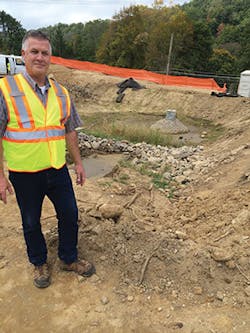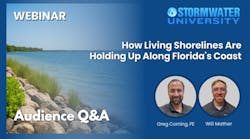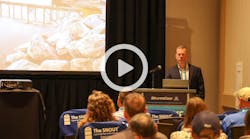Something that’s always bothered Jeffrey Econom, P.E., is that NPDES Phase I and Phase II regulations are based not upon physical characteristics, but on numbers: a 5-acre disturbance and a 1-acre disturbance. “I could go to an area that’s all sand, disturb 60 acres, and might have to go through a full SWPPP [stormwater pollution prevention plan],” he says. “But I can take a half-acre site that’s got a 40% slope next to wetlands and a Class A stream and—because it’s under 1 acre—the regulations are different. We need to start looking at the overall picture of the conditions of each site, such as appropriate slopes, environmental constraints, and water-quality issues.”
Econom is superintendent of public works for the Village of Pleasantville, NY. He is a Certified Professional in Erosion and Sediment Control (CPESC) a Certified Professional in Stormwater Quality (CPSWQ), a Certified Municipal Separate Storm Sewer Specialist (CMS4S), and Certified Professional Code Administrator (CPCA). He’s also affiliated with EnviroCert International, a nonprofit organization providing guidelines for the CPSWQ, CPESC, CMS4S, and Certified Erosion, Sediment, and Stormwater Inspector (CESSWI).
“A lot of municipalities will say there’s a threshold of 500 square feet of imperviousness and then you have to deal with it,” says Econom. “My philosophy is if we allowed that and every parcel that had disturbance, our infrastructure would be undersized. Most municipalities’ infrastructure has been in for up to 40 years or longer and is adequate or substandard. If you continue to increase runoff, it’s just going to make everything worse.” Econom proposed to Pleasantville’s village board that a runoff increase of any kind should be addressed. His proposal is now policy.
What Led Him to This Line of Work
Econom always had an interest in building construction. He earned a B.S. in civil engineering and an M.S. in environmental engineering from Manhattan College. In his first municipal job, he oversaw building permit applications for site development and dealt with erosion and sediment control. “I met Don Lake, one of the founders of the CPESC and CPSWQ programs, took the course, and obtained my CPESC certification,” says Econom, who went on to become a trainer. He would like to see such courses offered on a college level. “A lot of engineers and design professionals pretty much learn on the go,” he says. As a certified building inspector and a building inspector trainer in New York, Econom says that although he sees many bigger projects under control, smaller sites have become more constrained and lack scrutiny. “Building inspectors are approving plans with little or no erosion and sediment control practices,” he says.
Throughout his career, he has worked for the private and public sectors. Both lack education and training in keeping up with regulations, technology, and the appropriateness of a given approach to a situation, he says. He also sees a lack of communication among various groups, which he hopes the EnviroCert programs can address through training and certification. “Erosion and sediment control aren’t really any different from state to state,” he says. “Yes, we have different soil types and different vegetation. But consistency across the board would make it a lot easier for people. They move from job to job, state to state, and continue in the same practice.”
What He Does Day to Day
Econom oversees a staff of 30. He’s responsible for highway, water, sewer, sanitation, and parks, and he reviews building permit applications for stormwater compliance. Econom embraces flexibility. “In any part of the day, I could be working on a water problem, a sewer problem, an erosion problem,” he notes.
What He Likes Best About His Work
Interacting with the public and being able to assist people in finding a solution to a problem is Econom’s favorite part of the job. He enjoys his position with the village as well as his work with EnviroCert, through which he says he hopes to continue to provide influence and help in the erosion and sediment control field.
His Greatest Challenge
Trying to get projects done “the right way” and dealing with unfunded mandates is Econom’s biggest challenge. “You’re trying to come up with innovative ways to do things with little or no funds,” he says.


